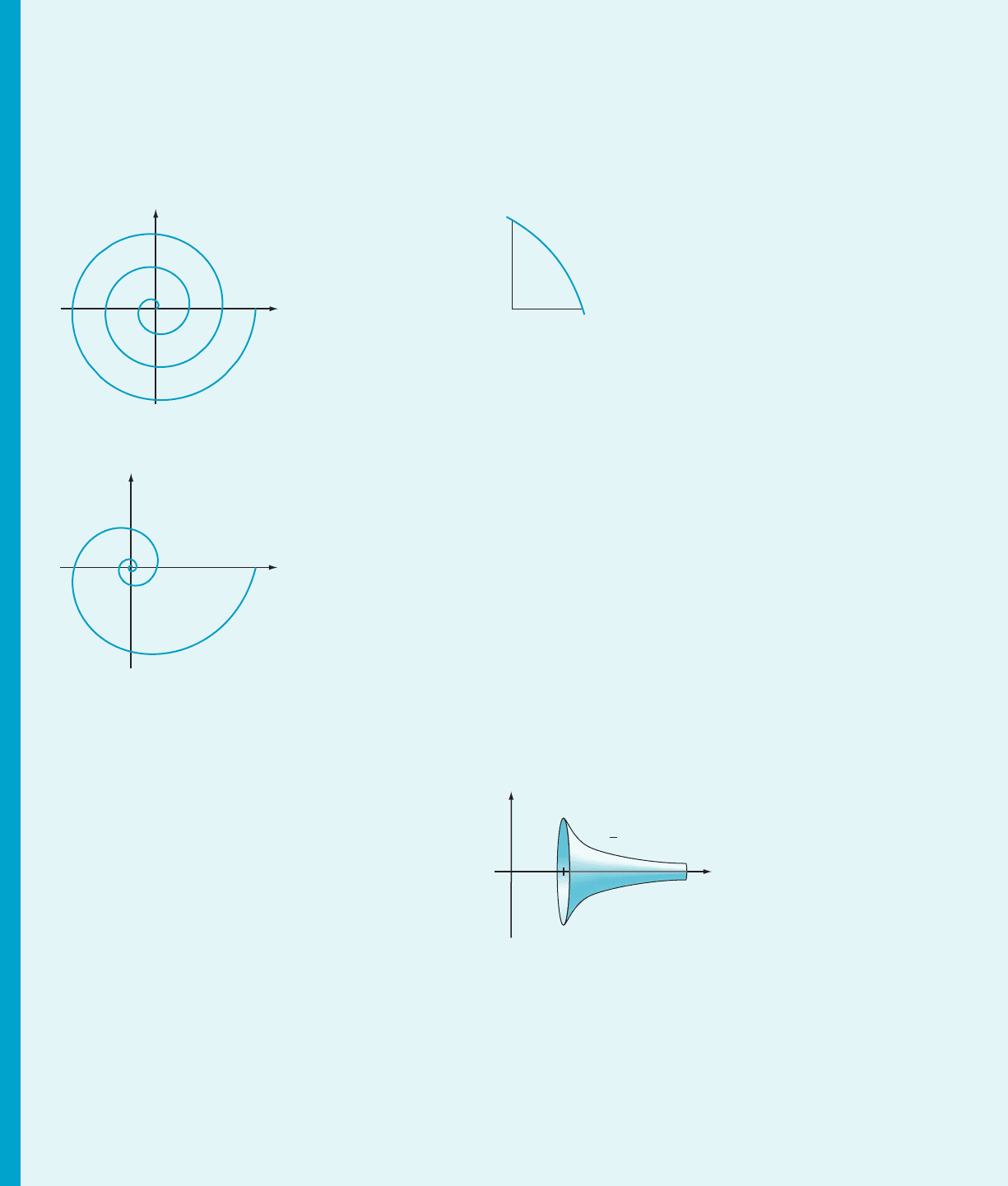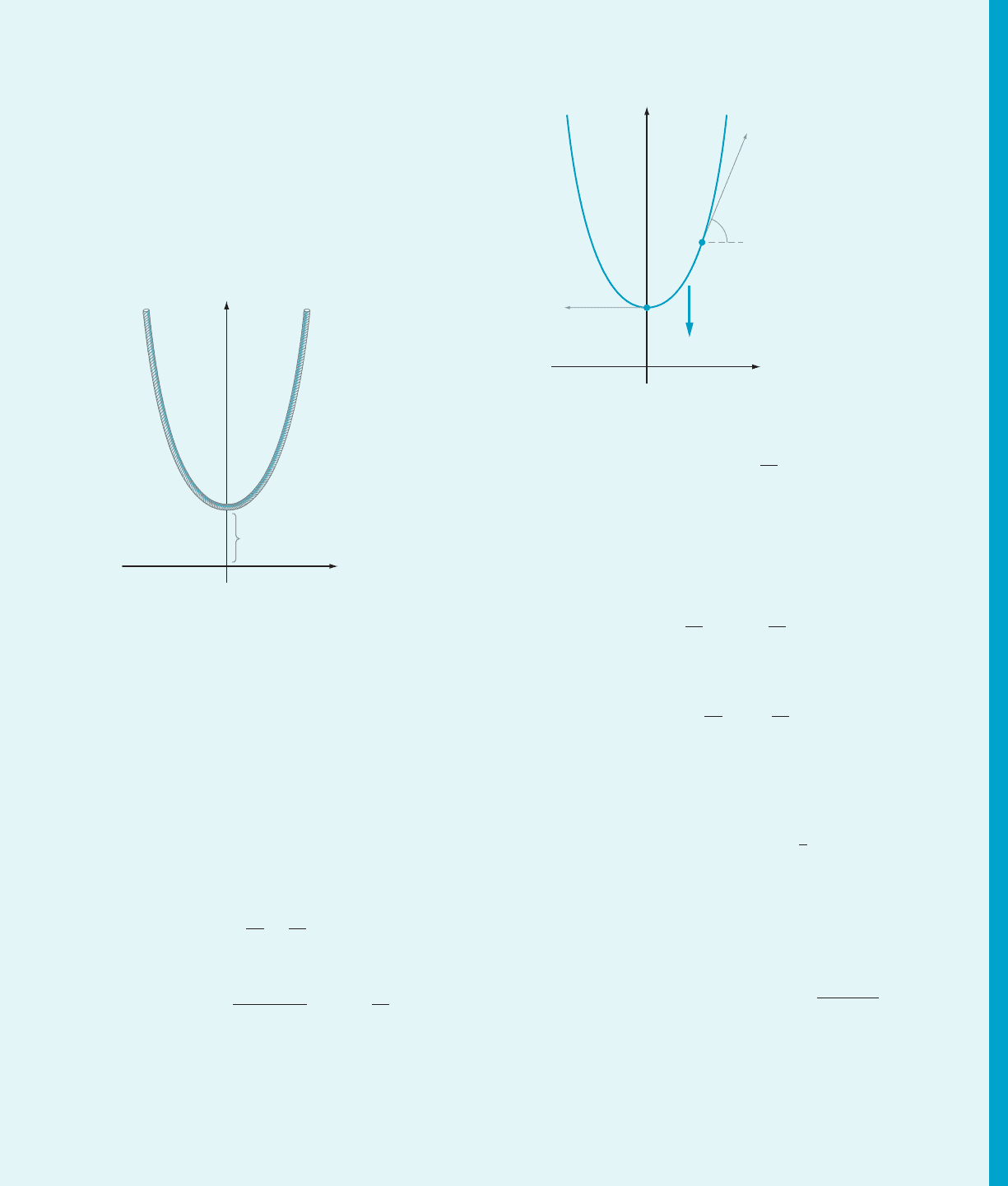Blank B.E., Krantz S.G. Calculus: Single Variable
Подождите немного. Документ загружается.


GENESIS
&
DEVELOPMENT7
Archimedes and the Sphere
Arc lengths, surface areas, and volumes—these con-
cepts were all investigated by the geometers of ancient
Greece. Archimedes, for example, demonstrated that
the volume enclosed by a sphere is 2/3 the volume
of the circumscribing cylinder and that the surface area
of a sphere is (also) 2/3 the area of the cir cumscribing
cylinder (including its circular ends). Stated more
explicitly, he proved that the volume and surface area
of a sphere of radius r are 4πr
3
/3 and 4π r
2
, respectively.
These results must have pleased Archimedes, for
he requested that his tomb be decorated with a sphere
and cylinder and that the ratio giving their relationship
be inscribed. His wishes were carried out, as we learn
from Cicero, who in 75
B.C. rediscovered and repaired
the overgrown, forgot ten site:
“I remembered some verses which I had been
informed were engraved on his monument, and
these set forth that on the top of the tomb there was
placed a sphere with a cylinder. . . . I observed a
small column standing out a little above the briers
with the figure of a sphere and a cylinder upon it . . .
When we could get at it. . . . I found the inscription,
though the latter parts of all the verses were almost
half effaced. Thus one of the noblest cities of
Greece, and one which at one time likewise had
been very celebrated for learning, had known
nothing of the monument of its greatest genius . . . .”
The restored grave of Archimedes eventually van-
ished again. However, in modern times, workers exca-
vating the site of a hotel in Syracuse reported coming
upon a stone tablet inscribed with a sphere and a cylinder.
Kepler and Solids of Revolution
In 1612, Johannes Kepler (15711630) took up residence
in Linz. As the wine harvest was good that year, the
Danube River banks were filled with wine casks. “This
being so,” in the words of Kepler’s biographer, Max
Caspar, “as husband and good pater-familias,hecon-
sidered it his duty to provide his home with the necessary
drink.” Accordingly, Kepler had some wine barrels
installed in his house. After seeing a wine merchant esti-
mate the volume of a cask by simply inserting a measuring
stick, Kepler set himself the problem of deve loping a more
scientific system of calculating volumes.
Inspired by these wine barrels, Kepler derived
formulas for the volumes of several solids of revolution
(not all of which were suitable for wine storage).
Among other results, he rediscovered Pappus’s for-
mula, 2πb πa
2
, for the volume of the torus, an inner-
tube-shaped solid that is generated when a disk of
radius a is revolved about an axis a distance b . a from
its center (Figure 1). The rigorous deductions of
Archimedes were somewhat beyond Kepler, who
resorted to the very free use of infinitesimal arguments.
In Kepler’s own words: “we could obtain absolute and
perfect proofs from the books of Archimedes if we did
not shrink from the thorny reading of his writings.”
Kepler published the results of his investigations in
1615 at his own expense. Despite Kepler’s strenuous
efforts to recoup his outlay, sales were limited to one
nobleman, two mathematicians, and a library.
Arc Length
The arc length problem (known then as rectification)
was also revived by mathematicians in the 1600s. Some
leading philosophers believed rectification to be inso-
luble. Descartes, for one, was emphatic on this point in
his G
´
eom
´
etrie: “The ratios between straight and curved
lines are not known, and I believe cannot be discovered
by human minds.” The idea that it might be possible to
compare the arc lengths of two different curves seems
to have originated with another philosopher, Thomas
Hobbes (15881679). Hobbes communicated his idea
to Rober val in 1642, and, by the end of that year,
Roberval was able to prod uce equal length arcs of the
Archimedean spiral
ffiffiffiffiffiffiffiffiffiffiffiffiffiffiffi
x
2
1 y
2
p
5 arctanðy=xÞ (Figure 2a)
and of the parabola y 5 x
2
/2. Three years later,
a
x
y
b
m Figure 1
625

Evangelista Torricelli calculated the arc length of the
logarithmic spiral shown in Figure 2b.
After a twelve-year hiatus, a number of arc length
calculations were published in quick succession. In
1657, William Neile (16371670) rectified the semi-
cubical parabola y
3
5 ax
2
. One year later, Christopher
Wren (16321723), better known as the architect of St.
Paul’s Cathedral, computed the arc length of the
cycloid. In 1659, the general arc length integral,
R
ffiffiffiffiffiffiffiffiffiffiffiffiffiffiffiffiffiffiffiffiffiffiffiffiffiffiffi
1 1 ðdy=dx Þ
2
q
dx, was obtained more or less simul-
taneously by Hendrik van Heuraet (1633?) and Blaise
Pascal.
The characteristic triangle or differential triangle,
the right “triangle” with dx and dy for legs and ds for
“hypotenuse” (Figure 3), appeared in the writings of
Blaise Pascal, who became interested in rectification
after learning of Wren’s result. During his study of
Pascal’s work in 1672, Leibniz realized that the differ-
ential triangle could become the basis of a method of
quadrature that supplemented its role in rectification. It
was this insight about arc length that led Leibniz to the
formula for integration by parts and provided him with
his first recognition of the relationship between tan-
gents (derivatives) and areas (integrals).
Torricelli’s Infinitely Long Solid of Revolution
In 1641, Evangelista Torricelli studied the infinitely
long solid that is obtained by rotating about the x-axis
the region in the first quadrant that is bounded above
by the graph of y 5 1/x, below by the x-axis, and on the
left by x 5 1 (see Figure 4). What is particularly inter-
esting about this solid is that despite its infinite length
and infinite surface area, it has finite volume. As had
been the case in ancient Greece, philosophy was not yet
prepared for the mathematical consequences of the
infinite. A spirited and personal exchange between
the philosopher Thomas Hobbes and the mathemati-
cian John Wallis erupted. As Wallis bluntly framed the
issue, an understanding of Torricelli’s solid “requires
more Geometry and Logic than Mr. Hobs is Master of.”
The reply of Hobbes was equally pointed: “I think Dr.
Wallis does wrong . . . for, to understand this for sense, it
is not required that a man should be a geometrician or a
logician but that he should be mad.”
The Catenary
The shape of a cable hanging freely under gravity
(Figure 5) was first determined in 1690 by Leibniz, who
coined the name “catenary,” and, independently, by
x a u cos(u)
y a u sin(u)
x
y
m Figure 2a Archimedean spiral
x a e
(bu)
cos(u)
y a e
(bu)
sin(u)
x
y
m Figure 2b Logarithmic spiral
dy
ds
dx
m Figure 3 Leibniz’s characteristic triangle
x
y
y
1
x
1
m Figure 4 A section of Torricelli’s infinitely long solid
626 Chapter 7 Applications of the Integral

Jakob Bernoulli. One interesting method of determi n-
ing the mathematical formula of the catenary relies on
a “variational principle” similar to Fermat’s Principle
of Least Time (Genesis and Development 4). Among all
curves of fixed length l joining two points P and Q, the
catenary arc of length l with endpoints P and Q has
lowest center of gravity, or, equivalently, the least
potential energy.
The theory of differential equations developed in
this chapter provides an alternative method for deriv-
ing the equation of the catenary. Let y(x) be the
function whose graph represents the hanging cable. Set
q(x)5y
0
(x). Two physical quantities are relevant: the
weight w of the cable per unit of length and the hor-
izontal tension T
1
at the lowest point of the cable (see
Figure 6). Because there is no lateral movement of the
cable, the horizontal forces must balance. When
translated into mathematics, the equation of horizontal
forces can be expressed by the separable first order
differential equation.
dq
dx
5
w
T
1
ð1 1 q
2
Þ
1=2
:
We rewrite this equation as
Z
1
ð1 1 q
2
Þ
1=2
dq 5
Z
w
T
1
dx:
Using integration formula (3.10.16) with a 5 1, we
obtain
sinh
21
ðqÞ5
w
T
1
x 1 C:
We know that the cable has a horizontal tangent
when x 5 0, the abscissa of point A in Figure 6. Thus we
have q(0) 5 y
0
(0) 5 0. From this initial condition, we
see that C 5 0. Thus our solution becomes sinh
21
(q) 5
wx/T
1
or q(x) 5 sinh(wx/T
1
). But q 5 y
0
. Therefore
dy
dx
5 sinh
w
T
1
x
:
We integrate this last equation to obtain
yðxÞ5
T
1
w
cosh
w
T
1
x
1 h;
where h is a constant of integration. (If h
0
is the
height of the point A from the x-axis, then h 5 h
0
2T
1
/
w.) In general, a curve whose equation is of the form
y 5 h 1 a cosh
x
a
for positive constants a and h is called a catenary. The
Gateway Arch in St. Louis, Missouri is very nearly an
inverted catenary. Its architectural plans speci fy the
equation
y 5 693:8597 2 68:7672 cosh
3:0022
299:2239
x
for the centroids of its cross-sections (when x and y are
measured in feet).
T
2
y
x
y
B
A
T
1
Force of
gravity 5 ws
u
m Figure 6
y
h
0
x
m Figure 5
Genesis & Development 627

The Catenoid
Suppose that P5(a, α) and Q5(b, β) are points in the
plane that lie above the x -axis. Suppose that P and Q
are joined by a curve C that is an arc of the graph of
a function f. Rotating C about the x-axis generates a
surface of revolution. Euler posed the question,
“Among all such surfaces of revolution, which has
minimal surface area?” Analytically, the question may
be asked in this way: Which function f satisfies f(a) 5 α
and f(b) 5 β and minimizes the integral
Iðf Þ5 2π
Z
b
a
f ðxÞ
ffiffiffiffiffiffiffiffiffiffiffiffiffiffiffiffiffiffiffiffiffiffiffiffi
1 1
f
0
ðxÞ
2
q
dx ?
The task of finding a function that minimizes an
integral such as I( f ) is substantially more complicated
than finding an extremum of a numerical function. This
kind of problem is studied in a branch of mathematics
called the calculus of variations. Euler solved his own
problem, pro ving that I( f ) is minimized when C is the
arc of a catenary. The surface of revolution is called a
catenoid. It arises naturally—indeed, you can generate
a catenoid with some wire and soapy water. Form wires
in the shape of two circles with different radii, bring
them together in a soap solution, and draw them apart
so that they are circles of revolution about the same
axis. The resulting soap film stretching between the two
circular wires will assume the shape of a catenoid. In
general, soap films give minimal surfaces. This fact can
be proved from thei r surface tension equati ons.
628 Chapter 7 Applications of the Integral

CHAPTER 8
Infinite Series
When we learn to write fractions in decimal form, we soon become aware that
some numbers result in a nonterminating sequence of digits. For example, when we
decimalize 1/3, we apply the long division algorithm. No matter how many times
we divide, we are left with a remainder. If we terminate the procedure after any
division, then we are left with 0.33 . . . 33, which is a little too small. If we round up
to 0.33 . . . 34, then the result is a number that is a little too great. We must
therefore accept that the decimalization of 1/3 is 0.333 . . . without end.
Of course, in grade school we do not pause long to reflect on the infinite
process that is symbolized by the trailing dots. Intuitively, we understand that the
notation must stand for the “infinite sum”
3
10
1
3
100
1
3
1000
1
3
10000
1
;
even if we have only a fuzzy idea of what that might mean.
Now that we have studied some calculus we are prepared to understand exactly
what such sums signify. The concept of “limit” that is needed for the infinite
processes of calculus is just what is needed to understand the infinite sums that arise
in grade school and elsewhere. In fact, our approach is nothing more than a
framework for turning our intuition into something precise. If you think of the
sequence
0:3 5
3
10
; 0:33 5
3
10
1
3
100
; 0:333 5
3
10
1
3
100
1
3
1000
; :::
as a sequence of approximations of 1/3 that become ever more accurate, then you
already have the key idea of understanding an “infinite sum” as a limit of its
“partial sums.”
Infinite sums are important in calculus, but they are not confined to mathe-
matical disciplines. If you study scientific subjects such as biology or thermo-
dynamics, then you are likely to encounter infinite sums in those pursuits. If you
learn about the money supply in economics or annuities in finance, then you will
see that infinite sums are needed for those concepts. This chapter will provide you
with a good basis for your understanding of infinite sums, wherever they arise.
In this chapter, we also study infinite sums
P
N
n50
a
n
ðx 2 cÞ
n
for which x is
treated as a variable lying in an interval centered at c. Such power series, as they are
PREVIEW
629

called, have found many applications in mathematics and science. Several impor-
tant differential equations from physics and engineering are best solved by power
series methods. Functions defined by power series have become fundamental tools
in the study of diverse subjects such as civil engineering, aeronautics, structural
geology, and celestial mechanics.
Power series are not used only to create new functions. In many cases, it is
important to be able to express the standard elementary functions by means of
power series. The question becomes, given a function f and a point c, can we find
coefficients {a
n
} for which f ðxÞ5
P
N
n50
a
n
ðx 2 cÞ
n
? The answer lies in the theory of
Taylor series, which is the focus of the last two sections of this chapter. Because
the partial sums
P
N
n50
a
n
ðx 2 cÞ
n
of a power serie s are polynomials, our study of
Taylor series will lead to powerful techniques for approximating functions by
polynomials.
630

8.1 Series
The idea of adding together finitely many numbers is a simple and familiar one. We
are so used to the properties of finite sums that we tend not to think about them.
Now we will learn about sums of infinitely many numbers, and we will have to be a
bit more careful. As the next example shows, contradictions can arise if we do not
establish certain ground rules.
⁄ EX
AMPLE 1 Group the terms of 21 1 1 2 1 1 1 2 1 1 1 2 1 1 in two
ways to produce diff erent results.
Solution If
we group the terms as (21 1 1) 1 (21 1 1) 1 (21 1 1) 1
,
then the
sum seems to be 0 1 0 1 0 1
,
which ought to be 0. On the other hand, if we
group the terms as 21 1 (1 2 1) 1 (1 2 1) 1 (1 2 1) 1
,
then the sum seems to
be 21 1 0 1 0 1 0 1
,
which ought to be 21. Apparently the associative law of
addition fails for this infinite sum.
¥
Example 1 points to the need for a precise definition that establishes what it
means to add infinitely many numbers. With a carefu lly conceived definition, sums
such as 21 1 1 2 1 1 1 2 1 1 1 2 1 1 are not given any meaning, and ambiguities
such as that of Example 1 do not arise. The key idea in the precise definition of an
infinite sum is the notion of a limit of a sequence. It is that concept that we review
next.
Limits of Infinite
Sequences—A Review
Recall that an infinite sequence fa
n
g
N
n51
is a list a
1
, a
2
, a
3
, . . . of terms indexed by the
positive integers. For example, 1, 1/2, 1/4, 1/8, 1/16, . . . is the infinite sequence
f1=2
n21
g
N
n51
of nonnegative powers of 1/2. Often it is convenient to begin a
sequence with a first index that differs from 1. Thus f1=2
n
g
N
n50
is another way to
write the sequence 1, 1/2, 1/4, 1/8, 1/16, . . . .
We say that a sequence fa
n
g
N
n51
converges to a real number ‘ (or has limit ‘) if,
for each A . 0, there is an integer N such that ja
n
2 ‘j, A for all n $ N. In this case,
we write lim
n-N
a
n
5 ‘, or, equivalently, a
n
- ‘ as n -N. A sequence that has a
limit is said to be convergent. If a sequence does not converge, then we say that it
diverges, and we call it a divergent sequence. Some ba sic convergent sequences are
lim
n-N
r
n
5 0ifr is a consta nt with jrj, 1; ð8:1:1Þ
lim
n-N
b
1=n
5 1ifb is a positive constant ; ð8:1:2Þ
and
lim
n-N
1
n
p
5 0ifp is a positive constant: ð8:1:3Þ
There are a few rules that, when used with these basic limits, enable us to easily
evaluate the limits of many common sequences. For example, if fa
n
g
N
n51
and
fb
n
g
N
n51
are convergent sequen ces, and if α is any real number, then
lim
n-N
c
n
5 β; if c
n
5 β for all n; ð8:1:4Þ
lim
n-N
ðα a
n
Þ5 α lim
n-N
a
n
; ð8:1:5Þ
8.1 Series 631

lim
n-N
ða
n
1 b
n
Þ5 lim
n-N
a
n
1 lim
n-N
b
n
; ð8:1:6Þ
lim
n-N
ða
n
2 b
n
Þ5 lim
n-N
a
n
2 lim
n-N
b
n
; ð8:1:7Þ
lim
n-N
ða
n
b
n
Þ5 ð lim
n-N
a
n
Þðlim
n-N
b
n
Þ; ð8:1:8Þ
and
lim
n-N
a
n
b
n
5
lim
n-N
a
n
lim
n-N
b
n
if lim
n-N
b
n
6¼ 0: ð8:1:9Þ
⁄ EX
AMPLE 2 Let
a
n
5
2n
4
1 3
ffiffiffi
n
p
2 5
3n
4
1 10
:
Use limit formula (8.1.3) to calculate lim
n-N
a
n
.
Solution We
divide each summand in the numerator and denominator of a
n
by the
highest power, n
4
, obtaining
lim
n-N
a
n
5 lim
n-N
2 1 3
ffiffiffi
n
p
=n
4
2 5=n
4
3 1 10=n
4
:
Observing that
lim
n-N
2 1 3
ffiffiffi
n
p
n
4
2
5
n
4
5 lim
n-N
ð2Þ1 lim
n-N
3
n
7=2
2 lim
n-N
5
n
4
5 2 1 3 lim
n-N
1
n
7=2
2 5 lim
n-N
1
n
4
5 2 1 3 0 2 5 0 5 2
and
lim
n-N
3 1
10
n
4
5 lim
n-N
ð3Þ1 lim
n-N
10
n
4
5 3 1 10 lim
n-N
1
n
4
5 3 1 10 0 5 3 6¼ 0;
we use limit formula (8.1.9) to conclude that lim
n-N
a
n
5 2=3. ¥
Example 2 has a generalization that is used frequently. If p
1
, p
2
, ...,p
k
and q
1
,
q
2
,...,q
‘
are constants with p
1
. p
2
. ... . p
k
$ 0 and q
1
. q
2
. ... . q
‘
$ 0, and
if c
1
, c
2
,...,c
k
and d
1
, d
2
, ..., d
‘
are constants with c
1
6¼0 and d
1
6¼0, then
lim
n-N
c
1
n
p
1
1 c
2
n
p
2
1 1 c
k
n
p
k
d
1
n
q
1
1 d
2
n
q
2
1 1 d
‘
n
q
‘
5
c
1
=d
1
if p
1
5 q
1
0ifp
1
, q
1
:
8
<
:
ð8:1:10Þ
In words, if the highest power in the numerator is the same as the highest power in
the denominator, then the limit is the ratio of the coefficients of the highest powers.
If the highest power in the numerator is less than the highest power in the
denominator, then the limit is 0.
In another important technique for calculating lim
n-N
a
n
, we treat the index
variable n as a continuous variable x that tends to infinity. Then we may apply
tools from calculus, such as l’Ho
ˆ
pital’s Rule. The next two examples illustrate
this idea.
632 Chapter 8 Infinite Series

⁄ EXAMPLE 3 Let a
n
5 n/e
λn
where λ is a positive constant. Calculate
lim
n-N
a
n
.
Solution Becau
se λ . 0, we have lim
n-N
e
λn
5 N and lim
n-N
a
n
has the
indeterminate form
N
N
. An application of l’Ho
ˆ
pital’s Rule shows that
lim
x-N
x
e
λx
5 lim
x-N
d
dx
x
d
dx
e
λx
5 lim
x-N
1
λe
x
5 0:
If we restrict the approach of x to infinity through integer values n, then we obtain
lim
n-N
a
n
5 0. ¥
⁄ EXAMPLE 4 Show that
lim
n-N
n
1=n
5 1: ð8:1:11Þ
Solution In
Example 10 of Section 4.7, we used l’Ho
ˆ
pital’s Rule to show that
lim
x-N
x
1=x
5 1. If we restrict the approach of x to infinity through integer values n,
then we obtain limit formula (8.1.11).
¥
The Definition of an
Infinite Series
If a
1
, a
2
, a
3
, . . . is an infinite sequence, then the (formal) expression a
1
1 a
2
1 a
3
1
is said to be an infinite series. It is convenient to extend the sigma notation
X
N
n5M
a
n
5 a
M
1 a
M11
1 1 a
N21
1 a
N
for finite sums that we introduced in Section 5.1 of Chapter 5. To signify an infinite
series, we simply use the symbol N for the upper limit of summation. Thus we let
P
N
n51
a
n
denote the infinite series a
1
1 a
2
1 a
3
1 For instance, if a
n
5 1/2
n21
,
then
P
N
n51
a
n
denotes the infinite series 1 1 1/2 1 1/4 1 1/8 1 1/16 1
Example 1 suggests that care is needed if we are to assign a value to the infinite
series
P
N
n51
a
n
. Nevertheless, there is a quite natural way to define and interpret
infinite series. Consider the decimalization of 1/3, namely 0.3333 . . . (ad infinitum).
In realit y, the decimal number 0.3333 . . . symbolizes the infinite series
P
N
n51
a
n
with
a
n
5 3/10
n
. If we need a decimal expansion that is accurate to two decimal places,
then we use a
1
1 a
2
5 0.33. If we require five decimal digits of 1/3, then we use
a
1
1 a
2
1 a
3
1 a
4
1 a
5
5 0.33333, and so on. By taking “partial sums” of the infinite
series
P
N
n51
a
n
, we obtain approximations that become closer and closer to the exact
value of
P
N
n51
a
n
. This familiar example suggests the method by which we define the
“sum” of an infinite series in general.
DEFINITION
If a
1
, a
2
, a
3
, . . . is an infinite sequence, then we say that the
expression
S
N
5
X
N
n51
a
n
5 a
1
1 a
2
1 1 a
N
is a partial sum of the infinite series
P
N
n51
a
n
. The sequence fS
N
g
N
N51
is said to be
the sequence of partial sums of the infinite series
P
N
n51
a
n
.
8.1 Series 633

⁄ EXAMPLE 5 Compute the sequence of partial sums of the infinite series
P
N
n51
ð21Þ
n
.
Solution Accord
ing to the definition, S
1
5
P
1
n51
ð21Þ
n
521, S
2
5
P
2
n51
ð21Þ
n
5
ð21Þ
1
1 ð21Þ
2
521 1 1 5 0, S
3
5
P
3
n51
ð21Þ
n
5 ð21Þ
1
1 ð21Þ
2
1 ð21Þ
3
521, and
so on. The sequence of partial sums of
P
N
n51
ð21Þ
n
is 21; 0; 21; 0; 21; 0;::: ¥
⁄ EXAMPLE 6 Find a formula for the partial sum S
N
5
X
N
n51
1
2
n21
of the
infinite series
X
N
n51
1
2
n21
.
Solution For
small values of N, ordinary addition yields the values of S
N
. For
example, we have S
1
5 1/2
0
5 1, S
2
5 1/2
0
1 1/2
1
5 3/2, S
3
5 1/2
0
1 1/2
1
1 1/2
2
5 7/4,
and so on. More efficiently, whenev er we calc ulate one partial sum, we can obtain
the next partial sum by adding the next term of the series. Thus S
4
5 S
3
1 1/2
3
5
7/4 1 1/8 5 15/8. To calculate the partial sum
S
N
5
X
N
n51
1
2
n21
5 1 1
1
2
1
1
2
2
1
1
2
3
1 1
1
2
N21
that corresponds to a general value of N, we use equation
1 1 r 1 r
2
1 1 r
N21
5
r
N
2 1
r 2 1
; r 6¼ 1 ð8:1:12Þ
from Theorem 4 of Section 2.5 in Chapter 2. If we specify r 5 1/2 in equation
(8.1.12), we see that
S
N
5
X
N
n51
1
2
n21
5 1 1
1
2
1
1
2
2
1
1
2
3
1 1
1
2
N21
5
1
2
N
2 1
1
2
2 1
5
1 2
1
2
N
1
2
5 2
1 2
1
2
N
5 2 2
1
2
N21
:
This general formula agrees with the specific calculations of S
N
for small values of
N that we performed at the beginning of the solution.
¥
Convergence of
Infinite Series
The meanin g that we give to the “sum” of an infini te series
P
N
n51
a
n
is determined
by the behavior of its sequence {S
N
} of partial sums as N tends to infinity.
DEFINITION
Let {S
N
} be the sequence of partial sums of an infinite series
P
N
n51
a
n
. If lim
N-N
S
N
5 S, then we say that the infinite series
P
N
n51
a
n
converges
to S. In this case, when we refer to
P
N
n51
a
n
, we mean the number S, and we
write
P
N
n51
a
n
5 S. We call S the sum or value of the infinite series. If the
sequence {S
N
} does not converge, then we say that the series diverges. A series
that converges is said to be convergent; otherwise, we say that it is divergent.
INSIGHT
The terms “convergent” and “divergent” suggest an analogy between
infinite series
P
N
n51
a
n
and improper integrals
R
N
1
f ðxÞdx. Indeed, the approaches to the
two concepts are similar. To calculate
R
N
1
f ðxÞdx, we compute
R
N
1
f ðxÞdx for large values
of N and take the limit of
R
N
1
f ðxÞdx as N tends to infinity. Analogously, to calculate
634 Chapter 8 Infinite Series
